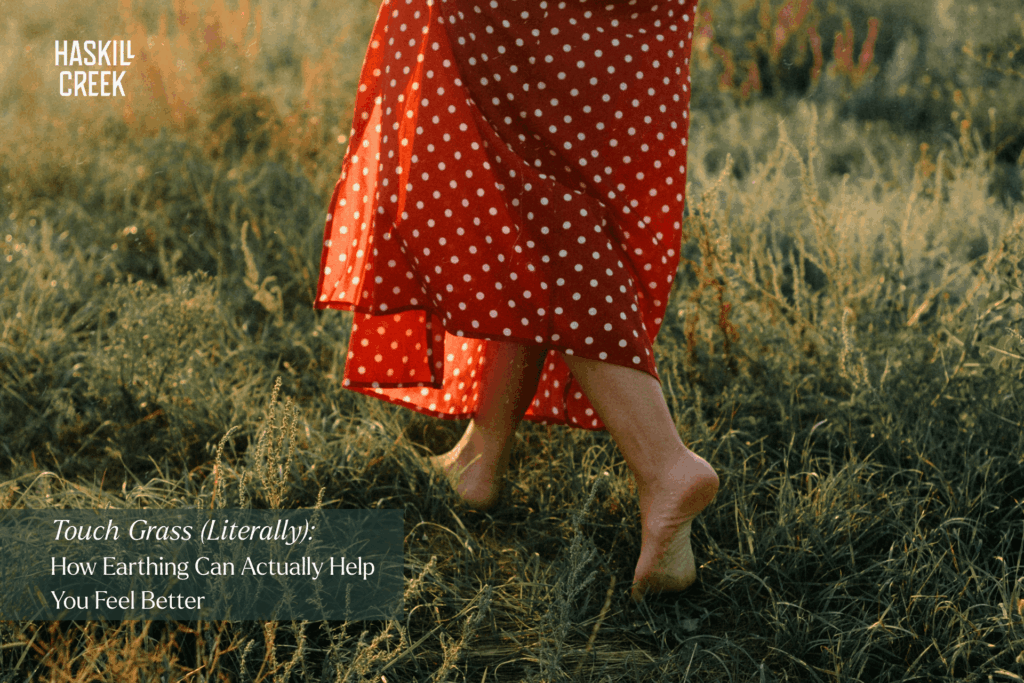Your Bag


When was the last time your bare feet touched the earth? Maybe you’ve heard the snarky phrase “go touch grass”—a modern way of telling someone to step away from their screen and reconnect with the real world. While it may be rooted in sass, the idea taps into age-old wisdom: being in nature is genuinely good for us- mind and body.
In fact, direct contact with the earth has been scientifically linked to benefits like reduced inflammation, improved immune response, faster wound healing, and even the prevention and treatment of chronic inflammatory and autoimmune conditions.[1] Not to mention measurable shifts in brain activity that affect mood, mindset, and overall mental health. Who knew that the answers to better health might be planted just beneath our feet.
Earthing- also known as Grounding- is the practice of making direct skin contact with the Earth. This can look like walking barefoot on grass, sand, or unsealed concrete, lying on the ground, or submerging in a natural body of water.
Long before science began exploring its effects, Indigenous cultures understood the healing interconnectedness of the Earth. Our ancestors walked barefoot, slept close to the ground, and held sacred ceremonies that honored nature with deep respect and reciprocity. Wellness wasn’t measured in data points, but felt as a fundamental part of living in harmony with the land.
Modern proponents of earthing point to the invention of rubber-soled shoes as a major factor in our disconnection. And today, in a world of city sidewalks and concrete sprawl, going barefoot isn’t always realistic. In response, brands now offer “grounding shoes”—specially designed footwear that mimics barefoot contact with the Earth. They typically feature leather footbeds and a small copper plug embedded in the sole, which conducts the Earth’s energy to your body. Check a version out here.
Speaking of energy- did you know the Earth is electric? Since the early 1900s, geoscientists and atmospheric physicists have understood that the Earth’s surface holds a negative charge.[2] When we make direct contact with it, these negatively charged ions can transfer to our bodies, helping to neutralize free radicals at the cellular level.
Our own bodies are electric, too. Our cells communicate via bioelectrical signals, our hearts beat with electrical currents (that’s what an EKG measures), and our brains fire with electrical impulses (measured by EEGs). Even the minerals in our bodies—like sodium, magnesium, potassium, and calcium—carry electrical charges. [3] This fascinating correlation makes me think about how electrolytes got their name, and how these charged particles help hydrate and energize us at a cellular level.
There’s even more to the science of syncing with the Earth. The Schumann Resonance—sometimes called the Earth’s heartbeat—is a vibrational frequency generated by electromagnetic waves in the Earth’s atmosphere. It’s been measured at 7.83 Hz, and some researchers believe that all life on Earth, including our brain waves, resonates with this frequency.[4]
Beyond physical grounding, there are other ways to “tune in” to the Earth’s natural frequency:
So, could Earthing really be nature’s antidepressant? Anecdotal reports say yes- and the science is beginning to back that up.
Electroencephalogram (EEG) studies on brain activity show that Earthing can immediately shift brainwave patterns and, over time, may help:
It’s not just the earth beneath our feet- natural water sources like waterfalls, rivers, and ocean waves also generate negative ions, which have been linked to improved mood, increased energy, and reduced stress. That might help explain why sitting near moving water feels so calming- it’s a form of grounding, too. [7]
One study had participants relax in recliners with eye masks, comparing simple rest to one hour including Earth contact. The grounded group reported a significantly greater boost in mood—suggesting the effects go beyond relaxation alone.
Another study measured real-time changes in brainwaves, showing that grounding may act as a neuromodulator, helping the brain and body adapt more effectively to environmental stress.
A findings summary puts it:
“Grounding appears to improve sleep, normalize the day–night cortisol rhythm, reduce pain, reduce stress, shift the autonomic nervous system from sympathetic toward parasympathetic activation, increase heart rate variability, speed wound healing, and reduce blood viscosity.”
How do you get started? Fortunately, it could be as easy as stepping into your backyard! Some benefits may be noticed immediately, but most proponents suggest regular Earthing for optimal benefits. Any amount of Earthing is better than none so a few minutes is great, up to 30 minutes- to an hour- and advanced Earthing might entail changes to your inside environment.
Practical, approachable tips:
Earthing mats, sheets, patches, and bands are designed to mimic the effects of direct contact with the Earth by connecting you to a grounded outlet or a rod placed in soil. These tools are especially marketed to people in urban environments, those who wear shoes most of the day, or anyone who has limited access to natural settings.
But are they as effective as the real thing? While grounding mats have shown potential benefits for sleep, inflammation, and stress, direct contact with nature remains the gold standard. More high-quality research is still needed to fully support commercial earthing products.
Final Thoughts
The great thing about Earthing is that it’s free, low-risk, and backed by research showing a myriad of benefits for mental health, stress reduction, improved sleep, and shifting the body into a healing state- all through natural exposure. Many people notice an immediate benefit just from the sensory experience, and the added sunlight is another bonus. Try it and see how you feel. It might just become part of your personal wellness equation, right alongside clean air, fresh water, nourishing food, and regular movement. So, go ahead- touch grass, hug a tree, walk barefoot, and gaze at the stars. It’s all part of tuning back in.

Join to get the Haskill Newsletter and be the first to learn about new products, events, and other goings-on at Haskill Creek!
